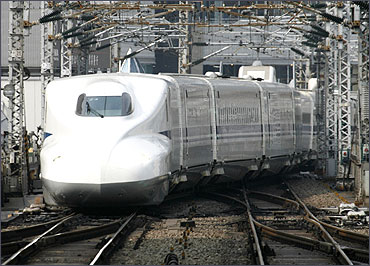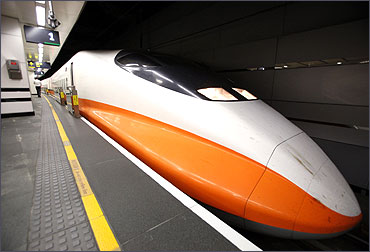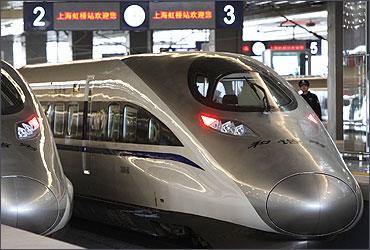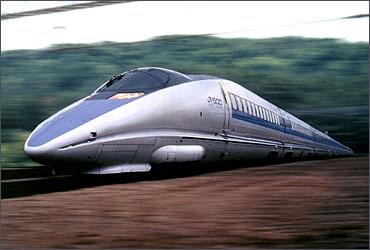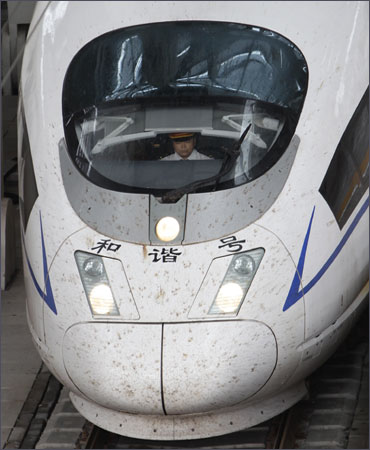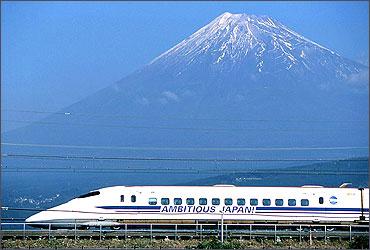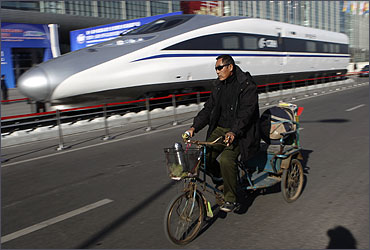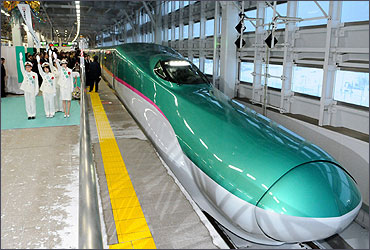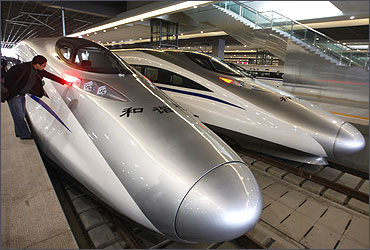 | « Back to article | Print this article |
Will India ever get such trains?
India has one of the largest rail networks in the world, yet it does not have any high-speed rail lines capable of supporting speeds of 200 km/h (124 mph) or more.
Click on NEXT for more...
Will India ever get such trains?
The Ministry of Railways' white-paper Vision 2020 submitted to the parliament by the then Railway Minister Mamata Banerjee on December 18 2009 envisages the implementation of regional high-speed rail projects to provide services at 250-350 km/h, and planning for corridors connecting commercial, tourist and pilgrimage hubs.
Click on NEXT for more...
Will India ever get such trains?
Six corridors have already been identified for technical studies on setting up of high-speed rail corridors: Delhi-Chandigarh-Amritsar, Pune-Mumbai-Ahmedabad, Hyderabad-Dornakal-Vijayawada-Chennai, Howrah-Haldia, Chennai-Bangalore-Coimbatore-Kochi, Delhi-Agra-Lucknow-Varanasi-Patna.
Click on NEXT for more...
Will India ever get such trains?
These high-speed rail corridors will be built as elevated corridors in keeping with the pattern of habitation and the constraint of land.
Click on NEXT for more...
Will India ever get such trains?
During Prime Minister Manmohan Singh's visit to Tokyo in December 2006, Japan assured co-operation with India in creating a high speed link between New Delhi and Mumbai.
Click on NEXT for more...
Will India ever get such trains?
In January 2009, the then Railway Minister Lalu Prasad Yadav expressed keen interest in introducing bullet-trains in India.
"The day is not far off when the bullet train will run in the country," Lalu had said after getting a first-hand feel of the superfast trains travelling from Tokyo to Kyoto at a speed of about 300 km/h.
Click on NEXT for more...
Will India ever get such trains?
On a visit to India in December 2009, the then Japanese Prime Minister Yukio Hatoyama offered bullet-train technology to India.
"Since its inception (in Japan), there has been no accidents. We will like to see this technology being used in India", said Hatoyama.
Click on NEXT for more...
Will India ever get such trains?
The feasibility study of the Ahmedabad-Mumbai-Pune corridor is complete. On March 21, 2011, the British firm Mott MacDonald was asked to conduct a pre-feasibility study on the 993km long Delhi-Agra-Lucknow-Varanasi-Patna route and report back in 7 months.
It will cost the Railways Rs 8.8 crore (Rs 88 million) for the report.
Click on NEXT for more...
Will India ever get such trains?
In a feasibility study published in 1987, RDSO and JICA estimated the construction cost to be Rs 49 million per km, for a line dedicated to 250-300 km/h trains.
In 2010, that 1987-estimated cost, inflated at 10 per cent a year = Rs 439 million per km.
Click on NEXT for more...
Will India ever get such trains?
In India, trains in the future with speed of 250-350 km/h, are envisaged to run on elevated corridors, to prevent trespassing by animals and people.
Click on NEXT for more...
Will India ever get such trains?
A public-private-partnership mode of investment and execution is envisaged for such expensive 250-350 km/h high-speed rail project.
The cost of building high speed rail tracks is about Rs 70 crore (Rs 700 million) per km, compared to Rs 6 crore (Rs 60 million) per km for normal rail tracks.
